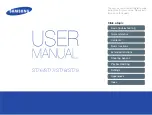
Thermographic measurement techniques
15
5. Measure the apparent temperature of the aluminum foil and write it down. The foil is
considered a perfect reflector, so its apparent temperature equals the reflected appa-
rent temperature from the surroundings.
Figure 15.5
Measuring the apparent temperature of the aluminum foil.
15.2.1.2
Step 2: Determining the emissivity
Follow this procedure:
1. Select a place to put the sample.
2. Determine and set reflected apparent temperature according to the previous
procedure.
3. Put a piece of electrical tape with known high emissivity on the sample.
4. Heat the sample at least 20 K above room temperature. Heating must be reasonably
even.
5. Focus and auto-adjust the camera, and freeze the image.
6. Adjust
Level
and
Span
for best image brightness and contrast.
7. Set emissivity to that of the tape (usually 0.97).
8. Measure the temperature of the tape using one of the following measurement
functions:
•
Isotherm
(helps you to determine both the temperature and how evenly you have
heated the sample)
•
Spot
(simpler)
•
Box Avg
(good for surfaces with varying emissivity).
9. Write down the temperature.
10. Move your measurement function to the sample surface.
11. Change the emissivity setting until you read the same temperature as your previous
measurement.
12. Write down the emissivity.
#T810252; r. AA/41997/41997; en-US
46
1.888.475.5235
info@FLIR-Direct.com
FLIR
-
DIRECT
.com
















































